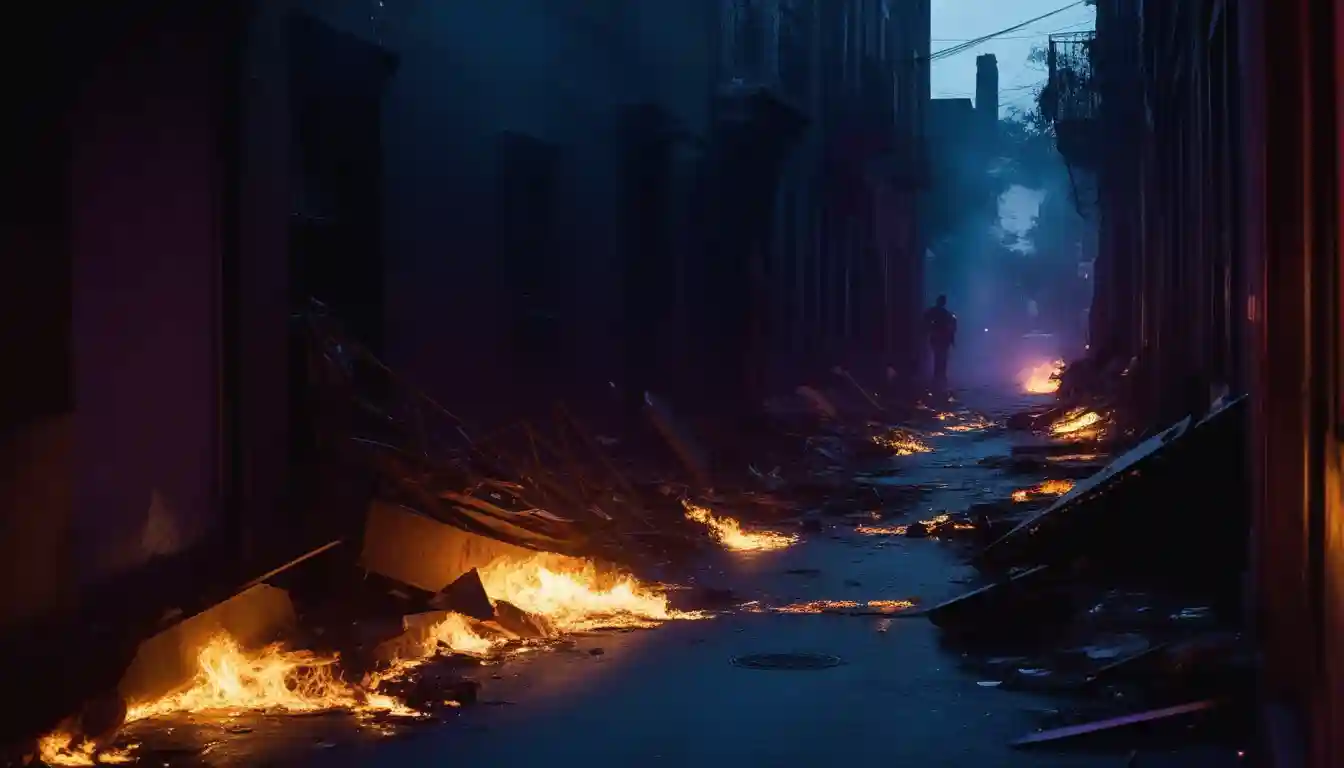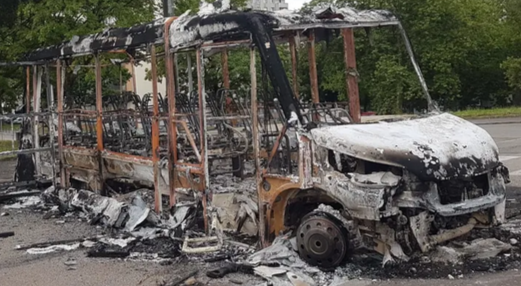
Night Battles Grip French Cities as Coordinated Gangs Overwhelm Police and Force Curfews
French Urban Violence: Inside the Night Battles Transforming Midsize Cities
*"This Isn't Random Chaos": The Coordinated Attacks Reshaping France's Urban Landscape
LIMOGES, France — Just after midnight last Friday, the RN141 highway outside Limoges transformed into what local authorities now describe as a "war zone." Approximately 150 masked individuals, armed with an arsenal of homemade weapons, executed what appears to be a meticulously planned assault on police, firefighters, and civilian infrastructure.

Émile Lombertie, the visibly exhausted mayor of Limoges, rejected the notion that the violence stemmed from youthful discontent. He characterized the attacks as structured urban guerrilla warfare with unprecedented tactical coordination.
The violence in Limoges marks the most dramatic episode in what security experts identify as an alarming new pattern of organized nighttime attacks gripping France's midsize cities. In recent weeks, similar coordinated violence has erupted in Compiègne, Nîmes, and Béziers, forcing local officials to impose curfews targeting minors in desperate attempts to restore order.
*The 3 A.M. Battlefield: How One Night Transformed Limoges
What began as a vehicle fire quickly revealed itself as a carefully staged ambush. As firefighters responded to the blaze, they found themselves caught in a pre-planned attack. Dozens of assailants, many positioned strategically in nearby apartment buildings, unleashed volleys of fireworks, Molotov cocktails, and improvised projectiles at first responders.
"I've served for 15 years, and I've never seen this level of organization," said a senior police officer who requested anonymity due to security concerns. "They had spotters, diversionary tactics, and appeared to be communicating throughout the assault."
The violence left at least nine police officers injured and multiple vehicles destroyed or damaged. Attempted carjackings were reported throughout the night, with the unrest continuing until dawn despite the presence of specialized police units.
Particularly troubling to authorities was the apparent ineffectiveness of a recently implemented curfew for those under 13 during summer holidays. "These weren't children breaking curfew," one city official acknowledged. "This was organized crime with clear tactical objectives."
*"Narco-Terrorists" and Child Soldiers: The Brutal Reality of France's New Urban Violence
In Nîmes, approximately 500 kilometers south of Limoges, authorities are confronting what they describe as an even more disturbing situation. Recent weeks have seen multiple gang-related shootings, including the brutal killing and burning of a 19-year-old in what investigators believe was connected to escalating drug territory disputes.
"We're facing narco-terrorists who have created a climate of fear and terror," said a senior security official in Nîmes, where authorities have imposed a night-time curfew for unaccompanied minors under 16 from 9 p.m. to 6 a.m. in six neighborhoods.
What particularly alarms child welfare advocates is the systematic exploitation of young teenagers by criminal networks. Children as young as 12 are being recruited as lookouts, couriers, and increasingly as frontline soldiers in these urban battles.
"They're using children because they face lighter penalties," explained Dr. Marie Dubois, a criminologist who specializes in youth violence. "It's a calculated business decision by criminal enterprises that view these children as expendable assets."
The violence has prompted significant security responses beyond curfews. In Béziers, which imposed curfews last year, restrictions have been extended to those under 15, while in Compiègne, approximately 30 youths attacked a police station with homemade mortars on the same night as the Limoges assaults.
*The Business of Violence: How Drug Networks Fuel France's Urban Warfare
The surge in organized violence corresponds with troubling data from France's anti-narcotics agencies. Drug-linked violence has claimed 110 lives and caused over 300 injuries in 2024 alone, according to government statistics.
Security analysts point to a fundamental restructuring of France's drug trade, with international networks increasingly establishing sophisticated distribution operations in midsize cities previously spared the worst urban violence.
"These aren't spontaneous riots—they're business operations," explained security consultant Antoine Lefèvre. "Control of territory equals market share in the drug economy. The violence we're seeing is essentially corporate competition in its most brutal form."
The economic stakes are substantial. A single drug point in these neighborhoods can generate €10,000-€15,000 daily, according to police estimates, creating powerful incentives for territorial control.
*Market Shockwaves: The Economic Fallout Begins to Spread
The violence has begun triggering economic consequences that extend far beyond the affected neighborhoods. Insurance markets are already pricing in heightened risk, with preliminary assessments suggesting potential insured losses approaching €400-600 million if current patterns continue—approaching the €730 million in damages from nationwide riots in 2023.
Corporate operations have faced direct impacts. In Limoges, manufacturing facilities operated by electrical equipment manufacturer Legrand sit within the security perimeter, while logistics operations on the critical RN141 corridor were physically blocked during the attacks.
"We're seeing companies implement contingency planning that was previously reserved for natural disasters," noted economic analyst Sophie Mercier. "This includes alternative supply routes, staggered shift times to avoid curfew windows, and substantial investments in physical security infrastructure."
Credit rating agencies have taken notice. Fitch recently introduced a dedicated scorecard for 133 French cities that explicitly incorporates security metrics. Analysts suggest municipal finances will face mounting pressure as security expenditures rise while tax bases potentially erode in affected areas.
*Beyond Curfews: The Search for Sustainable Solutions
While curfews represent the most visible response to the violence, security experts and community leaders increasingly question their effectiveness against highly organized criminal operations.
"Curfews can protect innocent minors, but they don't address the underlying economic and social conditions that make drug trafficking attractive to disenfranchised youth," argued Nadia Benali, who leads a community organization in one of Nîmes' affected neighborhoods.
The national government has responded with increased police deployments, specialized anti-drug units, and plans for high-security prisons targeting top traffickers. However, many municipal leaders argue these measures alone remain insufficient against the complex drivers of the violence.
Some cities are exploring more comprehensive approaches. In Béziers, despite ongoing challenges, officials have paired enforcement with expanded youth employment programs and targeted economic development in vulnerable neighborhoods.
"Security without opportunity creation is just temporary containment," observed a veteran urban policy expert who has advised multiple French administrations. "The cities making the most progress combine immediate security measures with pathways to legitimate economic participation."
For residents in affected neighborhoods, the stakes could not be higher. "This isn't just about drugs or gangs," said Karim, a 42-year-old father of three in Nîmes who declined to give his last name. "It's about whether our communities have a future where our children can walk the streets without fear—or without being recruited into violence."
This article contains analysis that reflects potential future scenarios and investment perspectives based on current market conditions. Past performance does not guarantee future results. Readers should consult financial advisors for personalized investment guidance.